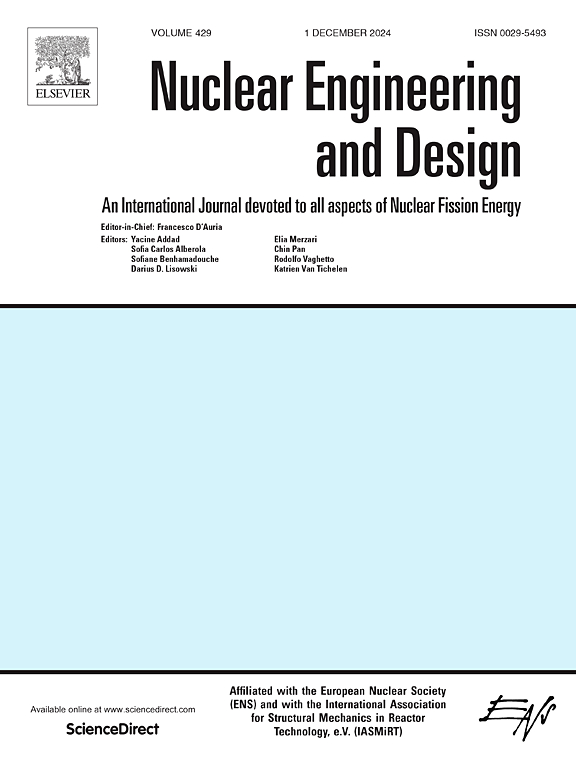岩屑床淬火的实验与数值研究及快速淬火人工神经网络的建立
IF 2.1
3区 工程技术
Q1 NUCLEAR SCIENCE & TECHNOLOGY
引用次数: 0
摘要
轻水堆堆芯劣化、RPV失效的超设计基础事故会在堆腔内形成碎片床。由于冷却水不足,碎屑床会熔化,与下面的混凝土相互作用,并在底部产生不凝气体,影响过热颗粒床的再注水的冷却性。原则上,像ATHLET这样的热液压系统代码可以考虑额外气体流量对淬火过程的影响。但是,还需要对各自的模型进行实验验证,并对相应的仿真结果进行验证。COCOMO的模型验证需要对现有的实验数据库进行特定的扩展,这在ATHLET中实现。由于像COCOMO这样的详细模拟代码可能需要很长的计算时间,因此需要快速运行的模型来进行概率风险分析。人工神经网络可用于快速估计淬火过程。在浮子试验装置上对单分散颗粒床进行了顶驱淬火实验,研究了外加不凝气体注入对单分散颗粒床顶驱淬火行为的影响。为验证模型,进行了连续数值模拟。由于多维模拟计算成本高,因此开发了一种人工神经网络来快速估计淬火过程。COCOMO模拟捕获了顶驱淬火的基本现象,但由于建模的3D效果而有所偏差,并且低估了NCG注入对淬火时间的影响。开发的人工神经网络同样低估了这种影响,但显示出快速淬火估计的希望。本文章由计算机程序翻译,如有差异,请以英文原文为准。
Experimental and numerical investigation on debris bed quenching and development of an artificial neural network for quick quenching estimation
A debris bed can form in the reactor cavity during a beyond-design-basis accident of light water reactors with core degradation and RPV failure. With insufficient cooling water, the debris bed can melt, interacting with the concrete underneath and generating non-condensible gases at the bottom, affecting coolability for re-flooding the superheated particle bed. Thermal-hydraulic system codes like ATHLET can, in principle, consider the impact of an additional gas flow on the quenching process. However, there is still a need for experimental validation of the respective models and the validation of the corresponding simulation results. A specific extension to the existing experimental database is needed for the model validation of COCOMO, which is implemented in ATHLET. Since detailed simulation codes like COCOMO can require long computation times, there is a need for fast-running models for probabilistic risk analysis. Artificial neural networks can be utilised for quick estimations of the quenching process. Experimental results are presented for the top-flooding quenching behaviour of a monodisperse particle bed with the influence of additional non-condensable gas injection conducted at the FLOAT test facility. Consecutive numerical simulations are carried out for model validation. Since multi-dimensional simulations are computationally expensive, an artificial neural network is developed for quick estimation of the quenching process. COCOMO simulations capture the basic phenomenology of top-flooding quenching but deviate due to modelled 3D effects and underestimate the influence of NCG injection on quenching time. The developed ANN similarly underestimates this effect but shows promise for quick quenching estimation.
求助全文
通过发布文献求助,成功后即可免费获取论文全文。
去求助
来源期刊

Nuclear Engineering and Design
工程技术-核科学技术
CiteScore
3.40
自引率
11.80%
发文量
377
审稿时长
5 months
期刊介绍:
Nuclear Engineering and Design covers the wide range of disciplines involved in the engineering, design, safety and construction of nuclear fission reactors. The Editors welcome papers both on applied and innovative aspects and developments in nuclear science and technology.
Fundamentals of Reactor Design include:
• Thermal-Hydraulics and Core Physics
• Safety Analysis, Risk Assessment (PSA)
• Structural and Mechanical Engineering
• Materials Science
• Fuel Behavior and Design
• Structural Plant Design
• Engineering of Reactor Components
• Experiments
Aspects beyond fundamentals of Reactor Design covered:
• Accident Mitigation Measures
• Reactor Control Systems
• Licensing Issues
• Safeguard Engineering
• Economy of Plants
• Reprocessing / Waste Disposal
• Applications of Nuclear Energy
• Maintenance
• Decommissioning
Papers on new reactor ideas and developments (Generation IV reactors) such as inherently safe modular HTRs, High Performance LWRs/HWRs and LMFBs/GFR will be considered; Actinide Burners, Accelerator Driven Systems, Energy Amplifiers and other special designs of power and research reactors and their applications are also encouraged.
 求助内容:
求助内容: 应助结果提醒方式:
应助结果提醒方式:


